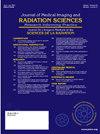改善乳腺癌放疗患者食管炎的毒性分级和管理
IF 2
Q3 RADIOLOGY, NUCLEAR MEDICINE & MEDICAL IMAGING
Journal of Medical Imaging and Radiation Sciences
Pub Date : 2025-05-01
DOI:10.1016/j.jmir.2025.101953
引用次数: 0
摘要
目的/目的:在该机构接受锁骨上淋巴结放疗的乳腺癌患者中,缓解疼痛漱口水(PRM)治疗轻度食管炎的处方使用有所增加。在2023年1月至2024年3月期间,49%的患者接受了PRM(要么是新开的处方,要么是被告知继续服用以前的处方),以帮助他们因放射治疗而改变饮食/吞咽。通常,2级食管炎需要干预,但数据显示1级比2级更常给予PRM。这是一个问题,因为它违反了标准化分级量表(CTCAE)指南,而且一种昂贵的、保质期短的处方只应该在必要时服用。目的是在6个月内将接受乳腺淋巴结放疗的1级食管炎患者使用止痛漱口水的比例从58.3%降低到15%。方法/流程一个跨学科团队合作研究如何在指南的基础上提高处方的一致性。我们制作了一份信息图表来指导放疗小组成员对食道毒性进行分级。临床教育工作者与注册护士和MRT(T)一起审查它,并将其张贴在临床区域。该研究的作者领导了一个教育会议,随后进行了一项调查,以收集对实施的反馈。在每周回顾中,对所有分级为1级毒性水平并给予PRM的乳腺淋巴结放疗患者进行跟踪。对研究前几个月治疗的患者的管理和分级进行比较,以确定实施改变想法后的趋势。1级食管炎患者每月服用PRM的百分比用图表表示。结果或益处/挑战本研究的益处是在数据驱动的质量改进工作之后减少了不必要的处方。对工作人员进行调查并报告授权,增加了对食管毒性分级的信心,提高了毒性评估技能。本研究的挑战在于样本量较小,且样本量会根据该科积极接受淋巴结性乳房放疗的患者数量而波动。最初观察到报告的毒性分级水平与指示何时需要干预的指南之间存在差异。仅在引入信息图一个月后,乳腺淋巴结放疗合并1级食管炎患者服用PRM的比例下降到33%。该研究正在进行中,预计在未来几个月内,在指南之外使用PRM的患者比例将进一步减少。减少处方PRM可以减轻患者在尝试不同管理策略之前购买漱口水处方的经济负担,并且还可以减少诊所的中断。本研究的一个潜在影响是将信息图的使用扩展到其他患者队列,并将其扩展到省级癌症护理团队。本文章由计算机程序翻译,如有差异,请以英文原文为准。
Improving Toxicity Grading and Management of Esophagitis for Radiotherapy Breast Cancer Patients
Purpose/Aim
An increase in the usage of prescriptions for pain-relieving mouthwash (PRM) for mild esophagitis has been noted in a population of breast cancer patients receiving radiotherapy with supraclavicular nodal irradiation in this institution. Between January 2023, to March 2024, 49% of patients were given PRM (either newly prescribed or were told to continue a previous prescription) to aid in altered eating/swallowing due to their radiation treatment. Typically, grade 2 esophagitis would require intervention, but this data showed PRM was given for grade 1 more commonly than grade 2. This is a problem as it goes against the standardized grading scale (CTCAE) guidelines and an expensive prescription which has a short shelf life should only be filled when necessary. The aim was to decrease the percentage of breast nodal radiotherapy patients with grade 1 esophagitis who are prescribed pain-relieving mouthwash from 58.3% to 15% within six months.
Methods/Process
An interdisciplinary team collaborated on how to improve congruency of prescribing based on the guidelines. An infographic was developed to guide radiotherapy team members in grading esophageal toxicities. Clinical educators reviewed it with both RNs and MRT(T)s and posted it in clinic areas. The study author led an education session, followed by a survey to gather feedback on the implementation. On weekly review, all breast nodal radiotherapy patients who were graded as grade 1 toxicity level and were given PRM were tracked. A comparison was made to the management and grading of patients treated during the few months preceding the study to determine trends after change ideas were implemented. The monthly percentage of patients prescribed PRM assessed at grade 1 esophagitis were graphed in a run chart.
Results or Benefits/Challenges
The benefit of this study is a reduction in unnecessary prescriptions following data driven quality improvement efforts. Staff were surveyed and reported empowerment with increased confidence in esophageal toxicity grading and sharpened toxicity assessment skills. The challenge of this study is that there is a small sample size that fluctuates based on the number of patients who are on active treatment for nodal breast radiotherapy in the department.
Conclusions/Impact
A discrepancy between the toxicity grading levels reported and the guidelines indicating when interventions are required was initially observed. Only one month after introducing the infographic, the percentage of breast nodal radiotherapy patients with grade 1 esophagitis who were prescribed PRM decreased to 33%. The study is ongoing and further reduction in the percentage of patients prescribed PRM outside of guidelines is expected in the coming months. Prescribing PRM less often could alleviate the financial burden for patients who were purchasing prescriptions for mouthwash before trying different management strategies and additionally reduce clinic disruptions. A potential impact of this study is to expand the usage of the infographic to other patient cohorts and to extend it to the provincial cancer care team.
求助全文
通过发布文献求助,成功后即可免费获取论文全文。
去求助
来源期刊

Journal of Medical Imaging and Radiation Sciences
RADIOLOGY, NUCLEAR MEDICINE & MEDICAL IMAGING-
CiteScore
2.30
自引率
11.10%
发文量
231
审稿时长
53 days
期刊介绍:
Journal of Medical Imaging and Radiation Sciences is the official peer-reviewed journal of the Canadian Association of Medical Radiation Technologists. This journal is published four times a year and is circulated to approximately 11,000 medical radiation technologists, libraries and radiology departments throughout Canada, the United States and overseas. The Journal publishes articles on recent research, new technology and techniques, professional practices, technologists viewpoints as well as relevant book reviews.
 求助内容:
求助内容: 应助结果提醒方式:
应助结果提醒方式:


